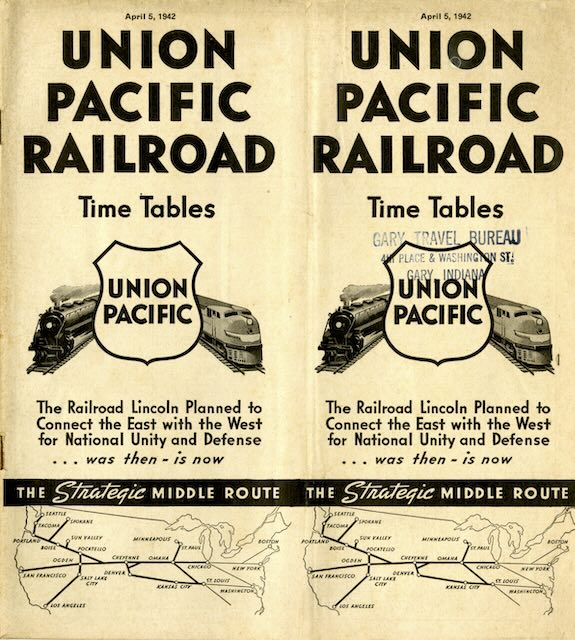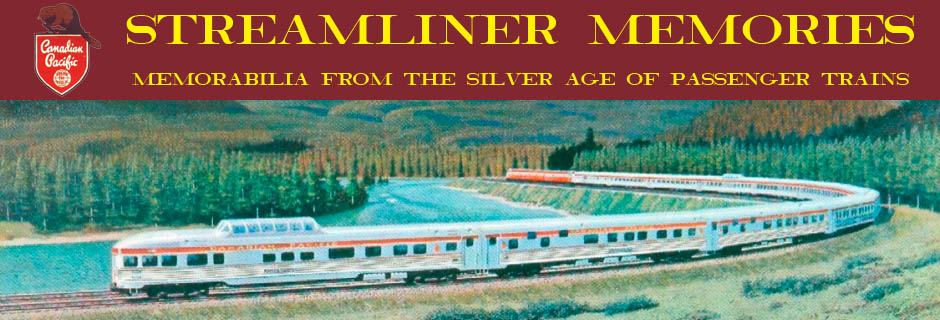Until the creation of Amtrak, the Great Northern, Northern Pacific, and Union Pacific “pooled” their passenger trains between Portland and Seattle. The trains were run mostly on tracks built by Northern Pacific but under some form of joint ownership. For most of those years, one train ran overnight and three trains operated in daytime service. The railroad that ran the overnight train changed from time to time according to the pool agreement.
 Click image to download an 43.9-MB PDF of this 64-page timetable.
Click image to download an 43.9-MB PDF of this 64-page timetable.
The train numbers shifted frequently but in 1942, Union Pacific’s daytime trains were numbered 458 southbound and 561 northbound. The companion train numbers, 459 and 562, were operated by one of the other railroads, which was especially odd because the other railroads used a different train station from Union Pacific in Seattle.
This timetable, however, shows a second daytime Union Pacific train, numbered 405 and 406. While all other Portland-Seattle trains were heavyweights, this one was called a streamliner and operated just 5 times a month — the same days that the City of Portland was scheduled to arrive or depart Portland for Chicago. In short, 405 and 406 was the City of Portland connection to Seattle.
This came about because UP was playing a game of musical streamliners in the late 1930s and early 1940s. After putting the six-car M-10001 into service as the five-times-a-month City of Portland in June 1935, UP realized the streamliners would be a hit so it ordered a nine-car M-10002 and placed it into service as the City of Los Angeles in May 1936.
In December 1937, the M-10002 was replaced by a 13-car train pulled by E-2 locomotives. A couple of months later, UP put the M-10002 back to work as a second City of Los Angeles train so it could offer streamliner service on that route 10 times a month instead of just five. However, that lasted only until August, after which the train was put back into storage.
In June 1939, the M-10002 became the City of Portland, bumping the M-10001 (which was scrapped). This lasted two years, after which the M-10004 (which had previously served as the City of San Francisco from 1936 to 1938 and the City of Los Angeles from 1938 to 1941) was made the City of Portland. Instead of making the City of Portland a ten-times-a-month service like the other two streamliners, UP put the M-10002 back into storage.
Starting with this timetable, however, the M-10002 went to work as the Portland-Seattle streamlined connection with the City of Portland. Naturally, some people were tempted to call it the City of Seattle, though the railroad never called it that and I don’t know if anyone in 1942 called it that or it was just a name used by railfans in later years.
The M-10002 included both sleeping cars and coaches. In Portland-Seattle service, seats in the sleeping car sections were sold as parlor seats. Although the train might attract some local customers because it was two hours faster than its heavyweight counterparts (partly because it made no intermediate stops other than Tacoma), I suspect it was mainly used by people transferring from or to the City of Portland, and thus people with sleeping car accommodations on the latter train had the same accommodations on the former.
The M-10002 was scheduled to leave Portland at 8:20 am, 20 minutes after the City of Portland was scheduled to arrive. It left Seattle at 2:30 pm, in time to arrive in Portland at 6:10 pm, 20 minutes before the City of Portland was scheduled to leave. The train had a lounge-diner and probably offered breakfast service on the Portland-Seattle morning leg and early dinner service on the Seattle-Portland afternoon leg.
Operating for less than four hours a day, ten days a month, this wasn’t a very efficient use of the train. It ran between Portland and Seattle for only about a year, after which the cars were either scrapped (aluminum being in great demand during the war) or transferred to other trains. The locomotives sat around until 1947 when they were sold (or perhaps loaned) to an aircraft company in the apparent hope that the company could adopt some of the latest style turboprop motors into ones suitable for train service.
The City of Portland was already 24 hours faster between Chicago and Portland than the Empire Builder or North Coast Limited. The M-10002 connection to Seattle made UP’s time from Chicago to Seattle 20 hours faster than its Northwest competitors. Even without the M-10002, it would have been nearly 18 hours faster, so it still seems like it would have been more effective to use the train for more frequent Chicago-Portland service than on the Portland-Seattle route.
Although this timetable is from my own collection, I’d like to thank Tim Zukas, whose timetables I’ve presented here before, for pointing out this unusual use of one of Union Pacific’s early streamliners.

Interesting to note that there was a through Los Angeles-Seattle sleeping car northbound. Undoubtedly this was exchanged with SP’s West Coast which ran up the San Joaquin Valley route from L.A. to Portland via Sacramento.
20-some years ago, helping research a book about Seattle Union Station for HistoryLink and Sound Transit, I came across Seattle newspaper coverage of this train. The Seattle papers were thrilled about Seattle finally getting its own streamliner, limited and shortlived as it was, after the insult of watching Portland get one first.